Monday, March 24, 2008
Hokkaido Winter Feast
Just to share more of the scrumptious bounties of Hokkaido! It's strange but the one word that best sums up the taste of Hokkaido seafood is "sweet". Seafood of all variety - crab, scallop, sea urchin, fish roe, all taste incredibly ... sweet!
1. Hokkaido crabs ("Kani" stands for crab in Japanese)
Kegani (Hairy crab), to be cooked nabemono (hotpot) style
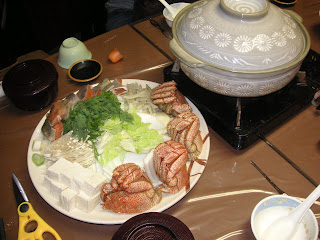
Tarabagani (King crab)

2. Squid ("Ika")
Fish for them yourself at the Hakodate Morning Market and have them sashimi-ed on the spot in a flash, by the deft hands of the storekeeper.

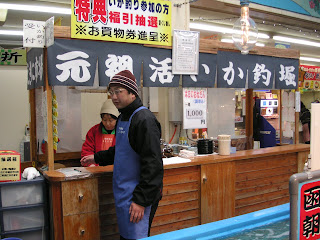

3. Salmon ("Sake")
Slabs of salmon cooked nabemono style
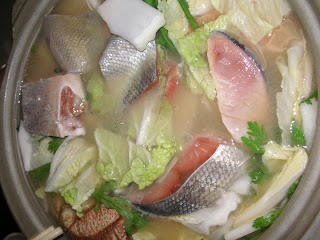
Salmon, prawns, scallops, plus the delightfully sweet (there's that word again!) sweet corn ("Tokibi") waiting to be grilled.

4. Chirashi Don (ricebowl with topping of raw seafood)
With seafood this fresh in Hokkaido, they are best savored raw!
Mock-ups of a variety of Chirashi Dons adorn the entrance of a stall at the Hakodate Morning Market. Just point and order!
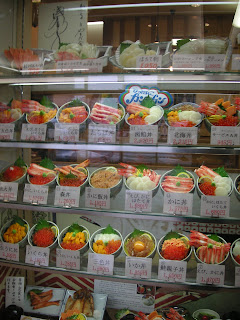
The holy trinity - Uni (sea urchin), Ikura (salmon roe) and Kani (crab). Three must-tries that I highly recommend. Definitely try them sashimi-style. A taste-sensation not to be missed!
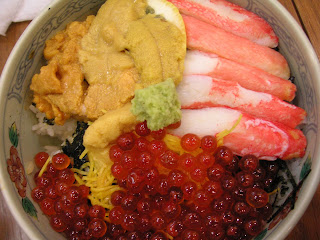
5. More raw (i.e. fresh) goodies
Sashimi platter of Amaebi (sweet prawn), Ika (squid) and Hotate (scallop). Again, you can try them at the Hakodate Morning Market - on my list of favorite Japanese markets now for incredible tasting sashimi and sushi, after the distinguished Tsukiji (Tokyo) market of course.

6. Ramen
The famed Ramen Yokocho (Alley) in Sapporo. A narrow stretch packed with the tiniest Ramen stalls that sit at most 8 -10 customers per stall.
Entrance

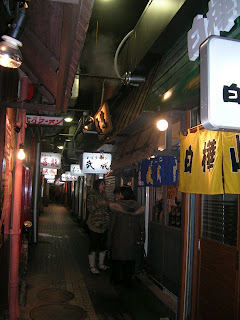
A steaming bowl of noodles in broth, with the usual servings of char siu (roast pork slices) and egg. Perfect pick-me-up for that winter night supper.

1. Hokkaido crabs ("Kani" stands for crab in Japanese)
Kegani (Hairy crab), to be cooked nabemono (hotpot) style
Tarabagani (King crab)
2. Squid ("Ika")
Fish for them yourself at the Hakodate Morning Market and have them sashimi-ed on the spot in a flash, by the deft hands of the storekeeper.
3. Salmon ("Sake")
Slabs of salmon cooked nabemono style
Salmon, prawns, scallops, plus the delightfully sweet (there's that word again!) sweet corn ("Tokibi") waiting to be grilled.
4. Chirashi Don (ricebowl with topping of raw seafood)
With seafood this fresh in Hokkaido, they are best savored raw!
Mock-ups of a variety of Chirashi Dons adorn the entrance of a stall at the Hakodate Morning Market. Just point and order!
The holy trinity - Uni (sea urchin), Ikura (salmon roe) and Kani (crab). Three must-tries that I highly recommend. Definitely try them sashimi-style. A taste-sensation not to be missed!
5. More raw (i.e. fresh) goodies
Sashimi platter of Amaebi (sweet prawn), Ika (squid) and Hotate (scallop). Again, you can try them at the Hakodate Morning Market - on my list of favorite Japanese markets now for incredible tasting sashimi and sushi, after the distinguished Tsukiji (Tokyo) market of course.
6. Ramen
The famed Ramen Yokocho (Alley) in Sapporo. A narrow stretch packed with the tiniest Ramen stalls that sit at most 8 -10 customers per stall.
Entrance
A steaming bowl of noodles in broth, with the usual servings of char siu (roast pork slices) and egg. Perfect pick-me-up for that winter night supper.
Of Kobe Beef & Abalone
Hokkaido, Japan
Being an incorrigible carnivore and a devout beef-eater, I just had to try the famed Kobe beef when it was offered on the menu of a restaurant in Hokkaido, Japan. And it's the original JAPANESE Kobe beef, not the wagyu-versions from Australia or USA that you'll usually find in restaurants all around the world, outside of Japan.
My knowledge of Kobe beef is rather superficial and my craving for the beef does stem from all that press about Kobe beef being the top-grade beef, regarded for its tender, highly marbled meat. Said marbled meat comes from some highly pampered cattle that roam the free ranges of Japan and feast on organic goodies such as barley, corn, wheat and beer (!) and they also receive regular stress-relieving massages, thus keeping the highly prized cattle nicely relaxed and retaining all its delicious, fatty, marbled flesh.
But press or no press, the Kobe beef does in fact, live up to all its hype! Eating the Kobe beef as slabs of grilled steak is quite possibly the best way to appreciate its flavour and texture. I've tried Kobe beef shabu shabu in Tokyo before and it just seems like such a bland way to taste the meat because if you love your beef, like I do, you'll wanna sink your teeth into substantial chunks of it and savour the juicy, beefy goodness of it all! Yum!
After savouring the Kobe beef, my curiosity (and greed) is piqued for the Matsuzaka and Mishima beef - two other highly lauded varieties that the Japanese regard to be even better than the Kobe beef (and possibly, even pricier no doubt)!

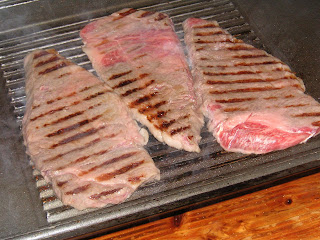
Another delicacy that I got to sample while in Hokkaido is the shellfish, abalone. Yet another pricey connoisseur food, though I am not quite sure if Japan's famed for its abalones. That said, the abalone we tried was DEEE-LI-CIOUS! Just simply grilled with butter, it was lip-smackingly good.
Below you'll find pictures of the abalones in their raw, cooking and cooked states. The abalones were actually writhing while being cooked alive. I'm just glad that abalones can't scream or it would have been quite an uncomfortable sight. On that note, the dining scene in Japan ain't exactly PETA-friendly. It's contentious I suppose, but sometimes you can't have your meat and eat it. And I'm all for eating!;p



Being an incorrigible carnivore and a devout beef-eater, I just had to try the famed Kobe beef when it was offered on the menu of a restaurant in Hokkaido, Japan. And it's the original JAPANESE Kobe beef, not the wagyu-versions from Australia or USA that you'll usually find in restaurants all around the world, outside of Japan.
My knowledge of Kobe beef is rather superficial and my craving for the beef does stem from all that press about Kobe beef being the top-grade beef, regarded for its tender, highly marbled meat. Said marbled meat comes from some highly pampered cattle that roam the free ranges of Japan and feast on organic goodies such as barley, corn, wheat and beer (!) and they also receive regular stress-relieving massages, thus keeping the highly prized cattle nicely relaxed and retaining all its delicious, fatty, marbled flesh.
But press or no press, the Kobe beef does in fact, live up to all its hype! Eating the Kobe beef as slabs of grilled steak is quite possibly the best way to appreciate its flavour and texture. I've tried Kobe beef shabu shabu in Tokyo before and it just seems like such a bland way to taste the meat because if you love your beef, like I do, you'll wanna sink your teeth into substantial chunks of it and savour the juicy, beefy goodness of it all! Yum!
After savouring the Kobe beef, my curiosity (and greed) is piqued for the Matsuzaka and Mishima beef - two other highly lauded varieties that the Japanese regard to be even better than the Kobe beef (and possibly, even pricier no doubt)!
Another delicacy that I got to sample while in Hokkaido is the shellfish, abalone. Yet another pricey connoisseur food, though I am not quite sure if Japan's famed for its abalones. That said, the abalone we tried was DEEE-LI-CIOUS! Just simply grilled with butter, it was lip-smackingly good.
Below you'll find pictures of the abalones in their raw, cooking and cooked states. The abalones were actually writhing while being cooked alive. I'm just glad that abalones can't scream or it would have been quite an uncomfortable sight. On that note, the dining scene in Japan ain't exactly PETA-friendly. It's contentious I suppose, but sometimes you can't have your meat and eat it. And I'm all for eating!;p
Craving Ice-cream in Hokkaido
Its winter in Hokkaido, Japan and what's the best snack to have? Ice cream of course! Lest you think I'm jesting, chilly climes make the best weather for ensuring that your cone doesn't melt off on you before you can finish it up.
But of course, the above rhetoric is merely an excuse to sample the smooth, velvety ice cream that Hokkaido has to offer. Some of the memorable finds:
1. Milk cones.
Hokkaido is famed for its milk and dairy products, so if you are ever within the vicinity of the Trappistine Convent while visiting Hakodate City in Hokkaido, do drop by this nondescript, teeny shop at the foot of the convent. Sample the fresh milk and of course, the milk-flavored ice-cream cones. This shop is actually rather famous for its creamy milk cones and people do make a special pilgrimage to the store just for it. And it's only one flavor on tap - milk. Yes, the milk taste is so divine, you don't need to mask it with the wishy-washy chocolate or strawberry flavorings. So if you're the sort who'll track to Île Saint-Louis while you're in Paris for the famed Berthillion ice-cream, this little outpost could be a stop on your Hakodate itinerary. Disclaimer: Having said that, I'm not saying that these milk cones are comparable to Berthillion ices. I wouldn't know, I have yet to try Berthillion. Damn!
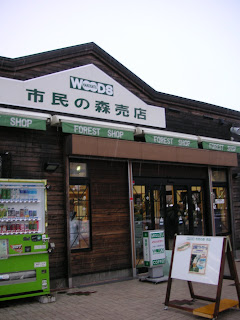
2. Flavors you'll never expect - Cheese and Potato
Yes, that's not the flavor on some packet of crisps or biscuits, but two novel flavors of ice cream. And the flavors go really well, chilled. Reminds me a bit of molecular gastronomy - the familiar tastes presented in unexpected forms. Hokkaido is famous for its dairy produce (thus, cheese) and potatoes. And once you eaten enough of the food in Hokkaido, you'll find that most of its stuff have a "sweet" quality to it. So yes, the cheese tastes sweet, the potato tastes sweet, even the scallop and salmon taste sweet! And this is not for a lack of vocabulary or range of taste buds on my end. So you'll discover that the "sweet" cheese and sweet-tasting potato can become credible flavor options for ice cream, as natural as you would have vanilla or chocolate.
Bought these at some random convenience store at a Tomamu ski resort. I really digged the potato flavored one!

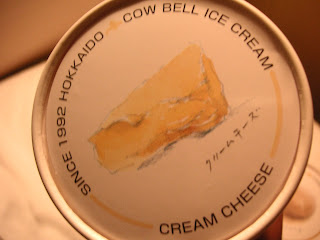
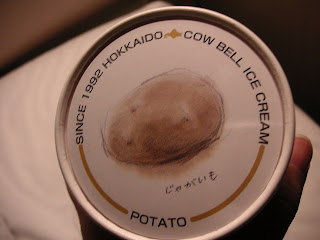
3. And it just keeps getting weirder - Squid Ink ice cream
Yeah, you heard it right. Squid. Ink. And as you can see, the ice cream retains the representative inky black colour of, what else, squid ink. The ice cream tasted rather nice actually, no weird tastes shocks here. To be honest, it tasted just like a nice, creamy confection. I couldn't really detect the squid ink, save for a slight savoury tinge. But then again, I don't know exactly how squid ink tastes like. I've tried squid ink pasta and arroz negro before, but you can't really isolate the squid ink taste in these dishes either, it's usually mixed in with all the other flavors. So, the squid ink ice cream is actually rather gimmicky. Perhaps good for a dare on an unsuspecting visiting friend or tourist? But that aside, the squid ink crepe I had, did make for an enjoyable mid-day snack.
Game to try them at the famed Hakodate Morning Market (Hakodate Asaichi)



But of course, the above rhetoric is merely an excuse to sample the smooth, velvety ice cream that Hokkaido has to offer. Some of the memorable finds:
1. Milk cones.
Hokkaido is famed for its milk and dairy products, so if you are ever within the vicinity of the Trappistine Convent while visiting Hakodate City in Hokkaido, do drop by this nondescript, teeny shop at the foot of the convent. Sample the fresh milk and of course, the milk-flavored ice-cream cones. This shop is actually rather famous for its creamy milk cones and people do make a special pilgrimage to the store just for it. And it's only one flavor on tap - milk. Yes, the milk taste is so divine, you don't need to mask it with the wishy-washy chocolate or strawberry flavorings. So if you're the sort who'll track to Île Saint-Louis while you're in Paris for the famed Berthillion ice-cream, this little outpost could be a stop on your Hakodate itinerary. Disclaimer: Having said that, I'm not saying that these milk cones are comparable to Berthillion ices. I wouldn't know, I have yet to try Berthillion. Damn!
2. Flavors you'll never expect - Cheese and Potato
Yes, that's not the flavor on some packet of crisps or biscuits, but two novel flavors of ice cream. And the flavors go really well, chilled. Reminds me a bit of molecular gastronomy - the familiar tastes presented in unexpected forms. Hokkaido is famous for its dairy produce (thus, cheese) and potatoes. And once you eaten enough of the food in Hokkaido, you'll find that most of its stuff have a "sweet" quality to it. So yes, the cheese tastes sweet, the potato tastes sweet, even the scallop and salmon taste sweet! And this is not for a lack of vocabulary or range of taste buds on my end. So you'll discover that the "sweet" cheese and sweet-tasting potato can become credible flavor options for ice cream, as natural as you would have vanilla or chocolate.
Bought these at some random convenience store at a Tomamu ski resort. I really digged the potato flavored one!
3. And it just keeps getting weirder - Squid Ink ice cream
Yeah, you heard it right. Squid. Ink. And as you can see, the ice cream retains the representative inky black colour of, what else, squid ink. The ice cream tasted rather nice actually, no weird tastes shocks here. To be honest, it tasted just like a nice, creamy confection. I couldn't really detect the squid ink, save for a slight savoury tinge. But then again, I don't know exactly how squid ink tastes like. I've tried squid ink pasta and arroz negro before, but you can't really isolate the squid ink taste in these dishes either, it's usually mixed in with all the other flavors. So, the squid ink ice cream is actually rather gimmicky. Perhaps good for a dare on an unsuspecting visiting friend or tourist? But that aside, the squid ink crepe I had, did make for an enjoyable mid-day snack.
Game to try them at the famed Hakodate Morning Market (Hakodate Asaichi)
Wasabi - I just can't get enough!
I adore sashimi and the ubiquitous condiment that goes with it -- the Japanese horseradish, wasabi. The green or mustardy paste just delivers such a kick to the raw fish slices.
So imagine my unbridled delight when I came across this bottled wasabi rice topping while I was shopping at the Otaru Seafood Market. Granted, it's bottled artificial flavoring, but it captured perfectly the fiery taste of wasabi in its minuscule pellets. Concocted with sesame seeds and seaweed flakes, this "powder-mix" is highly addictive when sprinkled liberally on top a bowl of fragrant, steamed white rice! Barely a month back from my trip, I've nearly emptied my bottle. Really regretted not stocking up on more!


So imagine my unbridled delight when I came across this bottled wasabi rice topping while I was shopping at the Otaru Seafood Market. Granted, it's bottled artificial flavoring, but it captured perfectly the fiery taste of wasabi in its minuscule pellets. Concocted with sesame seeds and seaweed flakes, this "powder-mix" is highly addictive when sprinkled liberally on top a bowl of fragrant, steamed white rice! Barely a month back from my trip, I've nearly emptied my bottle. Really regretted not stocking up on more!
Genius Invention - Liquid Plaster
I get nicked by paper cuts habitually and always lament the restrictions of the regular band-aid, where it's usually too big for the teeny cuts or does not conform well to the contours of the odd corners of the finger.
So I was delighted when I was introduced to the liquid plaster/bandage while I was in Hokkaido. Simply wash and wipe your cut and apply a thin layer of the liquid plaster and wait to dry. This way, you can ensure that the cut is fully protected, whatever weird angle it is located. Also, no more mucking around with over-sized plasters and stuffy bandages. The liquid plaster film will slough off naturally over time. As an added bonus the liquid has disinfectant qualities, great for wound-healing.
The Coloskin below is in a squeeze-tube form, but have come across other brands, some come with a convenient brush applicator. The liquid plaster can be easily found in pharmacies and costs around 700 - 900 yen.


So I was delighted when I was introduced to the liquid plaster/bandage while I was in Hokkaido. Simply wash and wipe your cut and apply a thin layer of the liquid plaster and wait to dry. This way, you can ensure that the cut is fully protected, whatever weird angle it is located. Also, no more mucking around with over-sized plasters and stuffy bandages. The liquid plaster film will slough off naturally over time. As an added bonus the liquid has disinfectant qualities, great for wound-healing.
The Coloskin below is in a squeeze-tube form, but have come across other brands, some come with a convenient brush applicator. The liquid plaster can be easily found in pharmacies and costs around 700 - 900 yen.
Subscribe to:
Posts (Atom)
